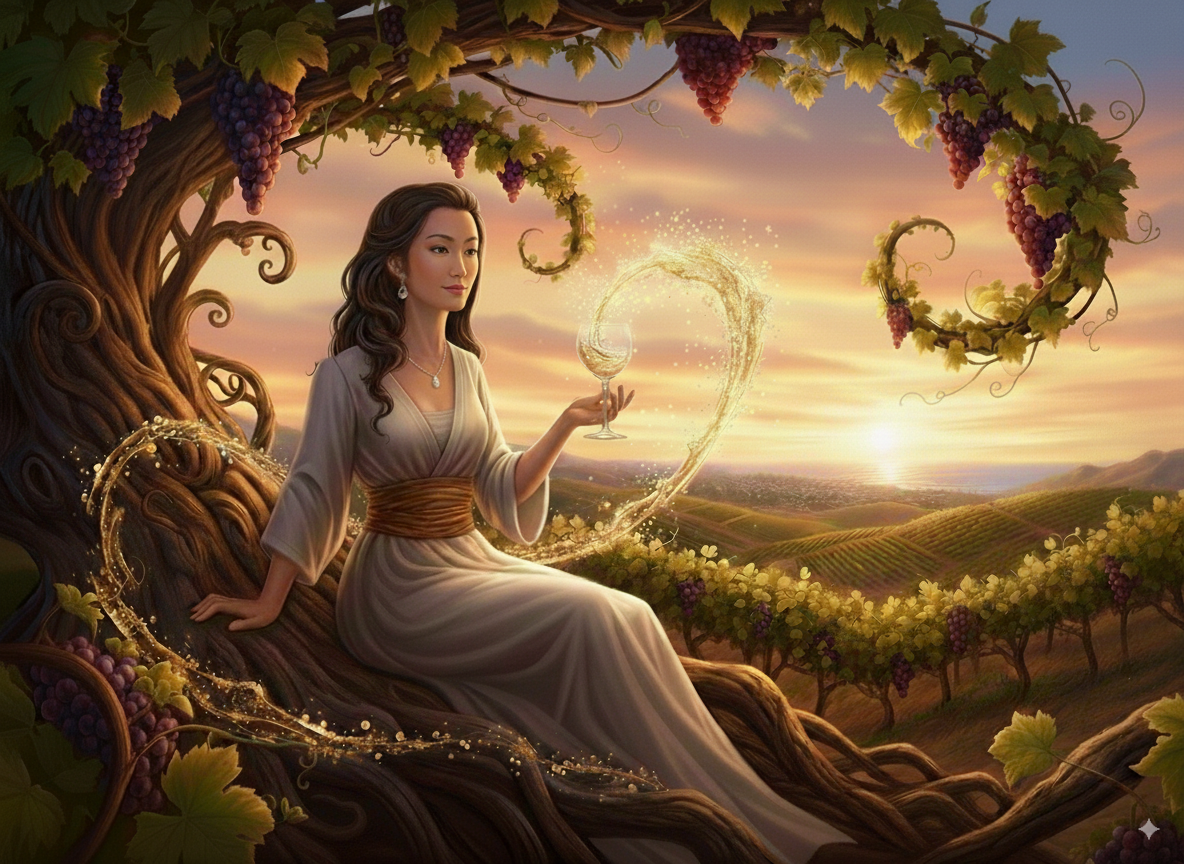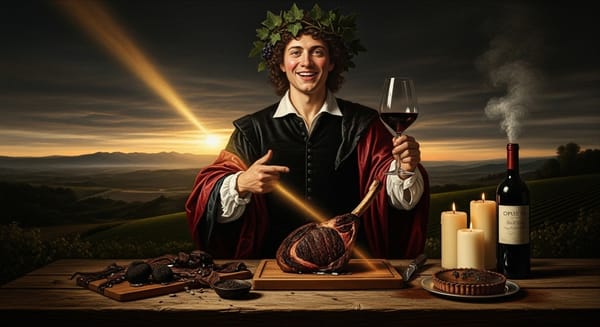Santa Barbara County: Where the Ocean Breathes Sideways
Santa Barbara County is a paradox of cold oceans and warm canyons, where Pinot Noir, Chardonnay, Rhône blends, and Bordeaux reds all find a voice. Discover how transverse valleys, marine fog, and innovative vintners craft wines defined by tension, texture, and timeless intrigue.

Morning arrives sideways in Santa Barbara County. Pacific fog slides inland like gauze drawn across a blade, breath‑cool against sun‑baked brush that still remembers yesterday’s heat. Ridge lines run east–west, defying California’s usual north‑south rhythm, so the ocean pours straight through the valleys, a daily tide of wind and light. Here, collision is the first language: sea meets stone, restraint meets ambition, and every bottle carries the tension of two climates arguing in the same glass. I taste that argument and feel time lengthen—centuries collapsing into aromatic minutes.
Tracks of Missionaries and Mavericks: An Evolving History
Long before grapevines braided themselves along these hillsides, the Chumash people harvested acorns, abalone, and coastal sage, mapping the seasons by tidal light. Their trade routes became the chalk lines upon which later settlers would march. In the late 18th century, Spanish missionaries arrived with vine cuttings of Mission grape, planting for sacrament rather than pleasure. The wine was coarse, sun-beaten—yet it proved the soil could speak.
The Mexican rancho era followed, and vineyards shrank under the weight of cattle profits. When California entered the Union in 1850, gold fever further eclipsed viticulture; vines persisted only in kitchen gardens and the odd hillside parcel. Prohibition (1920–1933) nearly silenced the region’s nascent wine voice, but a handful of Italian and Croatian families kept it alive, producing “altar wine” and selling grapes to home winemakers who shrugged at federal edicts.
The real ignition came post‑1960s, as Vietnam veterans, surfers, and UC Davis graduates converged on inexpensive land that smelled of possibility. Richard Sanford and Michael Benedict surveyed weather data like treasure maps, realizing the transverse valley’s climate mirrored Burgundy more than Napa. Their 1971 Pinot Noir planting at Sanford & Benedict Vineyard drew curious onlookers; among them was Jim Clendenen, whose Au Bon Climat would soon persuade the world that elegance could thrive under California sun.
As the 1980s unfolded, Bien Nacido Vineyard emerged as a grand cru‑caliber site, supplying fruit to a generation of restless winemakers. The Santa Rita Hills AVA (now Santa Rita Hills) was approved in 2001, formalizing what growers already knew: the sideways valley was a terroir of its own accord. A Hollywood moment arrived in 2004 when the film Sideways turned Pinot Noir into pop culture currency, sending tourism soaring and further diversifying plantings.
Today the history is still wet ink. Third‑generation farmers partner with boundary‑pushing newcomers; sustainability certifications replace the old metrics of tonnage; and every harvest rewrites the archive. In Santa Barbara, the past remains an active ingredient—yeast in the dough of what’s yet to ferment.
Fog Funnels & Rotated Ranges: The Pulse of Place
Santa Barbara’s landscape is a geological hinge—the mountains once sheared from the continent and pivoted clockwise, carving a transverse corridor that funnels marine air far inland. Santa Rita Hills, perched in that corridor, feels perpetually sea‑sprayed: diatomaceous earth flashes white under sparse grasses, and calcium‑rich soils echo limestone’s grip. Ballard Canyon tilts north–south within the larger valley, gathering both maritime chill and inland warmth; its limestone and sandy loam give Syrah a pulse that oscillates between pepper and plum. Farther east, Happy Canyon basks in ninety‑degree afternoons after the marine layer recedes, its serpentine cobbles and loam nurturing late‑ripening Bordeaux grapes. At the northern edge, Santa Maria Valley receives Vandenberg fog so faithfully that harvest can linger until Thanksgiving, stretching acidity like a taut bowstring.
Farming on the Brink of Wind
Growers here farm on the rim of possibility. Ocean winds thicken grape skins; sunlight, filtered through morning mist, slows sugar yet accelerates flavor. Many vineyards—Bien Nacido, Radian, Stolpman—are dry‑farmed or minimally irrigated, trusting deep roots to translate stone into song. Crews work by hand on steep ridges, pruning for balance rather than bulk. Sustainability is cultural, not cosmetic: cover crops against erosion, owl boxes for gopher patrol, year‑round employment for field teams, as Stolpman’s La Cuadrilla program attests.
Varietal Voices: From Violin to Drum
Cross the county and you move through a symphony that changes instruments every dozen miles. On the western ledge near Lompoc, Pinot Noir plays first chair—its tones are high‑pitched yet refined, like a violin brushed at dawn. The grape’s thin skin welcomes the ocean’s chill, developing aromatics that lean toward pomegranate and tea leaf rather than jam. Beside it, Chardonnay stretches on slopes streaked with diatomaceous earth; chilled mornings preserve nerve, so the wines feel as if citrus rind were scraped against wet stone.
Slip inland to Los Alamos and Ballard Canyon and the atmosphere warms just enough to invite the Rhône family. Syrah lands center stage, all violet perfume and cracked pepper, but its expression splits in two: on limestone ridges it can taste like graphite scraped by thyme, while in sandy pockets it trends toward black plum and cocoa. Grenache, ever the extrovert, gathers sun‑rich red fruit yet still dances lightly on its feet, and Mourvèdre provides the bass line—earthy, resonant, unhurried.
Farther east in Happy Canyon, Bordeaux voices rise. Cabernet Sauvignon ripens fully without losing tension, giving wines that recall blackberry layered with cedar. Cabernet Franc speaks in lifted herb notes—sage blossom, poblano—and often finds its way into blends that temper Cabernet’s tannic swagger. Merlot offers supple mid‑palate texture, like suede against the skin, while Petit Verdot deepens color and length like the final brushstroke on a canvas.
The county’s whites widen the spectrum: Sauvignon Blanc from Happy Canyon carries lime zest over a flinty spine; Viognier in Alisos Canyon shows honeysuckle aromatics yet braces itself with coastal acidity; and Roussanne in Ballard Canyon tastes of baked pear and chamomile brewed over embers. Even experimental plantings—Grüner Veltliner, Gamay Noir, Chenín Blanc—find small niches, each winemaker testing which fringe can still sing.
Styles echo geography. In the west, vintners chase transparency: whole‑cluster ferments, native yeast, neutral oak. Toward the interior, the extra heat invites longer macerations, new barrels, the occasional flash of opulence. Yet across all zones, freshness remains the through‑line; the Pacific’s long arm never quite releases its grip.
Cellars of Curiosity: Philosophies in Motion & Viticultural Philosophy
Santa Barbara’s cellar doors rarely close on dogma. Native fermentations stand beside precision‑chilled tanks; some barrels are seasoned in narrative—old puncheons that retain whispers of past vintages—while concrete eggs brood in calm corners. Minimalism rules the western edge: Rajat Parr and Sashi Moorman at Sandhi favor gentle extractions and large neutral oak to let oceanic tension sing through the wines. In Ballard Canyon, Stolpman experiments with whole‑cluster "So Fresh" cuvées, bottling early to trap vitality. Across the county, the mantra remains: let the site finish the sentence the winemaker begins.
Faces at the Frontier: Stories in the Rows
Dawn begins on the gentle slopes of Bien Nacido, where vineyard manager Chris Hammell inspects vine rows still damp from the marine layer. Owners the Miller family have treated this land like a living archive since 1973, parceling out blocks of Pinot Noir and Chardonnay to talented outsiders—Clendenen, Brewer‑Clifton, Paul Lato—who treat each pick as an annotated footnote in a decades‑long dialogue. Walk the rows at first light and you’ll hear picking crews switching between Spanish and a soft laugh; the fruit moving toward waiting bins feels less like commerce, more like an annual conversation with the earth.
Thirty minutes south, Jim Clendenen’s legacy at Au Bon Climat still hums through the corridors of an old warehouse at the Santa Maria airport. Assistant winemaker Trey Fletcher coaxes nuanced tones from old‑vine Pinot, aging it in well‑traveled François Frères barrels whose staves have seasoned through recessions and recoveries alike. Tasting there feels like stepping into a jazz session: the oak keeps time while acid and fruit improvise.
Follow Highway 246 west and you arrive at the angular ridges of The Hilt Estate. Winemaker Matt Dees compares Radian Vineyard to an open‑air wind tunnel where the fruit’s natural modesty must be coaxed, never forced. His Pinots often start at eleven percent alcohol, creeping only to twelve after a slow ferment; they taste like red fruit etched into stone rather than painted on canvas. Dees smiles when he pours them, as though letting you in on a long‑running joke between himself and the Pacific.
Head inland to Ballard Canyon, and you’ll likely catch Peter Stolpman pacing between limestone rows, barefoot, a notebook tucked beneath his arm. The “La Cuadrilla” crew—vineyard stewards turned shareholders—run pruning shears like sculptors’ chisels, crafting Syrah that marries rosemary, iron, and black plum in a kind of terrestrial handshake. Their experimental “So Fresh” bottlings skip prolonged extraction, bottling vitality while the fruit still speaks in exclamation points.
Further east, the rolling oaks of Happy Canyon shade Dragonette Cellars’ Cabernet blocks. Brothers John and Steve Dragonette, alongside Brandon Sparks‑Gillis, treat Cabernet Sauvignon not as a cudgel of power but as an expression of site—showing that sun and serpentine soils can produce structure without swagger. Their Bordeaux blends layer tobacco, green olive, and graphite, like pages in a well‑kept field journal.
And then there are the edge‑pushing voices: Graham Tatomer bottling citrus‑edged Grüner Veltliner from Kick‑On Ranch; Angela Osborne crafting Grenache under her Tribute to Grace label with the tenderness of a sonnet; Jaffurs Wine Cellars coaxing Viognier and Petite Sirah into bold but balanced canvases in an unassuming Santa Barbara city warehouse. Each producer seems to sense that the county’s sideways geology invites sideways thinking—a license to reinvent without losing respect for those who first staked trellis posts in exile against the coastal wind.
Time's Influence: Rest, Reveal, Reverence: Rest, Reveal, Reverence
Santa Barbara wines age on their nerve. Santa Rita Hills Pinot Noir gathers mushroom and tea after a decade while keeping its coastal backbone. Ballard Canyon Syrah evolves into smoked‑meat depth without losing violet lift. Happy Canyon Cabernet’s tannins, sun‑forged yet ocean‑tempered, knit by year seven and can coast two more decades. Cellar them cool (55 °F), horizontal, and dark; decant young Rhône reds for an hour to tame the wind still trapped inside, but treat older Pinots gently—like reading a letter creased by time.
Collecting Edges: A Cultural Case for Patience
Collectors often ask how to “position” Santa Barbara in a portfolio. The sharper question is how to position their curiosity. These wines are born of edges—geological, climatic, philosophical—and edges attract future value because they resist replication. Age underscores that singularity: a 15‑year‑old Au Bon Climat Pinot tastes less like Burgundy’s echo than like fog given memory. Acquire with patience, cellaring not for bragging rights but to witness metamorphosis. In a market chasing sameness, bottles that argue with convention become cultural capital.
Evening Lessons: On Restless Grace
Evening returns the valleys to sea. Cool air flows back toward the horizon, carrying eucalyptus breath and salt. In that exhale, Santa Barbara repeats its lesson: greatness rarely grows in comfort. It blossoms where plates collide, winds wrestle, and people remain stubborn enough to translate turbulence into grace. The wines, like the place, stay restless—always turning toward whatever light is left.





